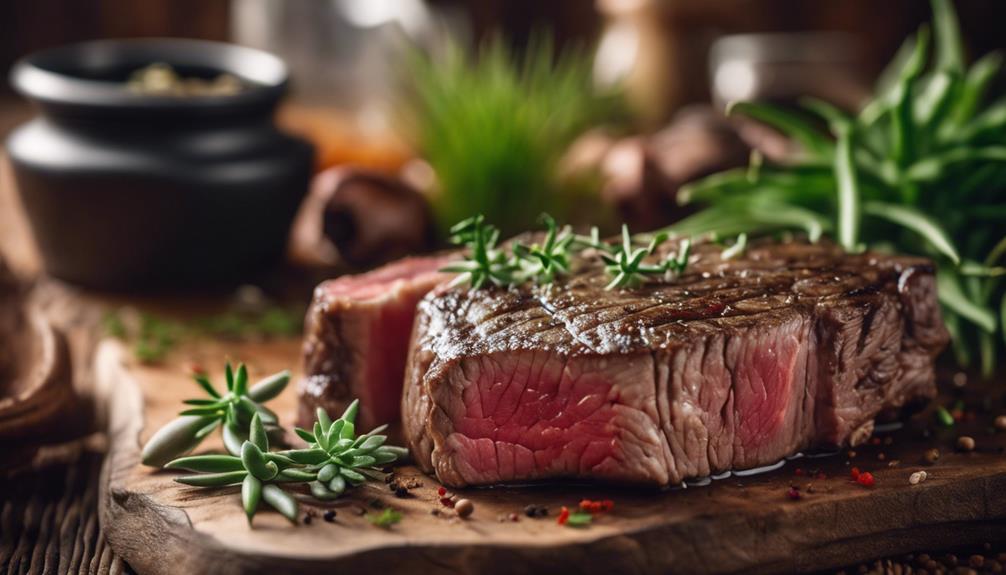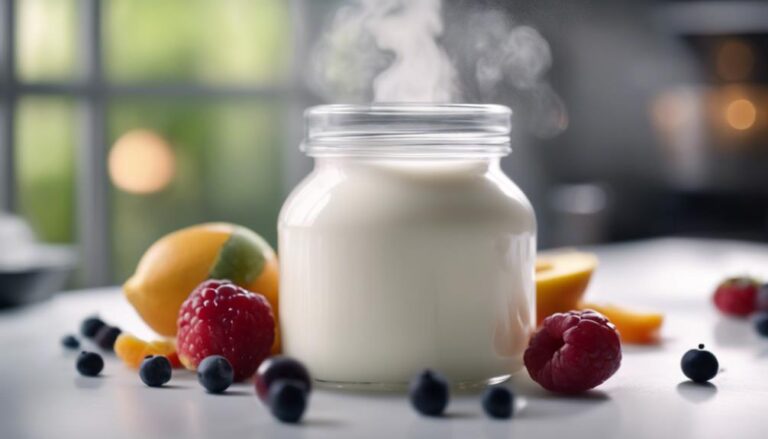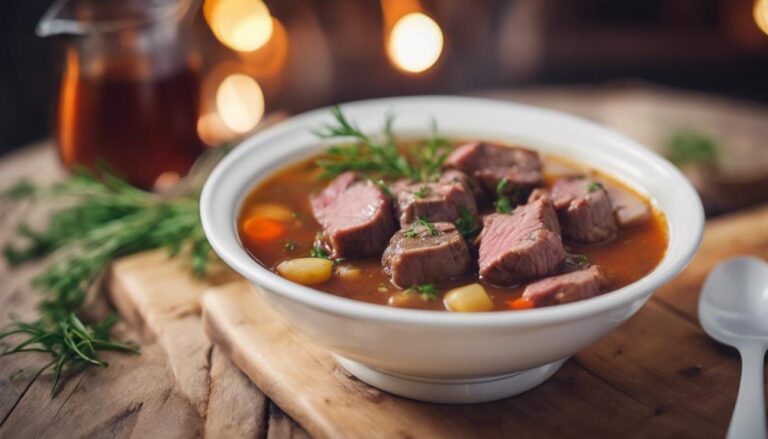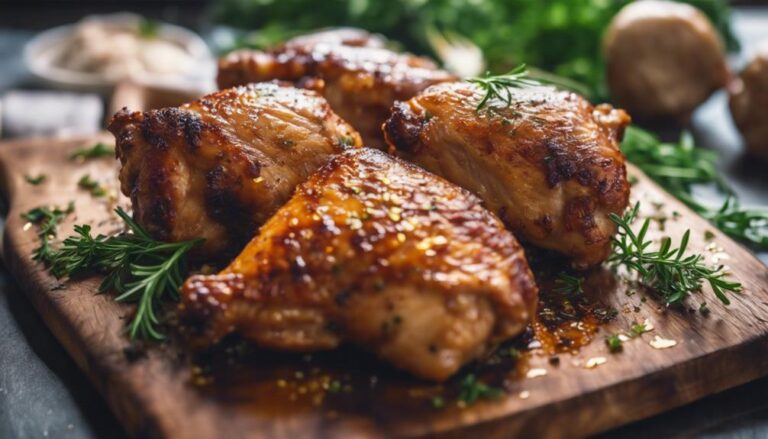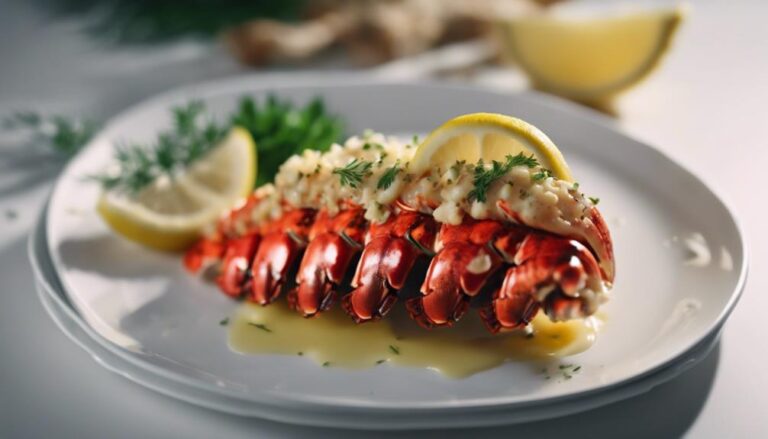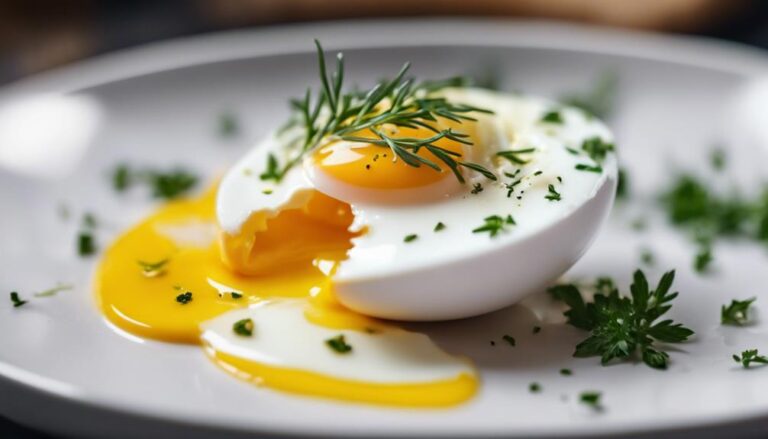Meat Mastery: Unleashing the Power of Sous Vide in a Carnivore Diet
You're about to elevate your carnivore diet with the precision of sous vide. This method's consistent temperature control tenderizes even the toughest cuts, ensuring every bite oozes flavor. Begin by selecting high-fat meats, perfect for sous vide's low and slow approach. Don't skimp on quality; sustainable sourcing pays off in taste. Experiment with seasoning to reveal new flavor dimensions. Seal in moisture with the right vacuum techniques, then finish with a sear for that irresistible crust. Pair with zero-carb sides to keep your meals diverse yet diet-compliant. Mastering these elements transforms your meals, hinting at a culinary journey just beginning.
What You Will Learn Here
- Sous vide ensures precision cooking, perfect for the high-fat cuts favored in a carnivore diet.
- Vacuum sealing with sous vide enhances flavor infusion, elevating the taste of meat.
- Temperature control with sous vide guarantees tender, flavorful meat, aligning with carnivore diet preferences.
- Experimenting with zero carb condiments and animal-based garnishes complements the carnivore diet while utilizing sous vide techniques.
- Sous vide cooking is energy efficient, offering an advantage over traditional methods for those on a carnivore diet.
The Sous Vide Revolution
The Sous Vide Revolution has fundamentally transformed the way you cook meat, offering unparalleled precision and consistency. Delving into sous vide history, you'll find its roots in culinary innovation, initially harnessed by chefs seeking to perfect the art of cooking. This method, involving vacuum-sealed food cooked in a precisely controlled water bath, has transcended professional kitchens, finding its place in homes where serving high-quality dishes becomes a form of care and hospitality.
Equipment innovation has been pivotal, making sous vide accessible to you. Modern devices are sleek, user-friendly, and more importantly, emphasize water bath safety, ensuring you can cook with peace of mind. Precision cooking benefits are at the heart of sous vide's appeal. You're not just cooking; you're experimenting with temperatures and times to achieve results impossible with traditional methods. Each steak, chicken breast, or pork chop emerges perfectly done, satisfying even the most discerning palates you're serving.
Moreover, the energy efficiency aspects of sous vide cooking can't be overlooked. Unlike conventional ovens that require preheating and can lead to energy waste, sous vide cookers use energy more judiciously, aligning with your commitment to sustainability while still serving exquisite meals.
Understanding Carnivore Diets
With the evolution of cooking techniques, especially sous vide, exploring carnivore diets offers a fascinating opportunity to further refine your culinary skills and understanding of meat's role in nutrition.
As you investigate this dietary approach, it's essential to dissect the health benefits it touts, alongside the dietary risks it carries. The carnivore diet, centered on animal products, promises improved digestion and mental clarity, attributing these perks to the elimination of plant-based irritants. However, this diet's strict framework raises concerns about nutrient sourcing. Ensuring a diverse intake of animal products is key to mitigating potential deficiencies in vitamins and minerals typically sourced from plants.
Diving deeper, it's important to debunk carnivore myths that suggest such a diet is universally beneficial. Individual responses vary, and an adaptation period is often necessary as your body shifts from a conventional diet. This phase can reveal whether your system aligns with such a drastic nutritional change. Analyzing these elements with precision allows you to serve others not just meals that delight the palate but also ones that nurture the body, respecting individual health needs and dietary preferences.
Essentials of Sous Vide Cooking
Diving into sous vide cooking, you'll quickly discover that precision in temperature control is your greatest ally in achieving meat that's consistently tender and flavorful. This method demands a meticulous approach, where equipment selection becomes paramount. Opting for a reliable immersion circulator guarantees your water bath remains at the exact temperature needed for the duration of cooking, which can span hours for ideal flavor infusion.
When serving others, understanding the essentials of sous vide is essential:
- Equipment Selection: Choose a vacuum sealer and bags that withstand prolonged heat exposure, ensuring your meat is perfectly sealed for its water bath journey.
- Safety Precautions: Adhering to recommended temperatures is crucial not just for texture but for safety, preventing harmful bacteria from spoiling your culinary efforts.
- Recipe Sources: Research and experiment with recipes from trusted sources. This exploration will refine your ability to marry the right spices and herbs, enhancing the natural flavors of the meat.
Sous vide cooking is both an art and a science, allowing for an experimental approach to flavor infusion. By adhering to these guidelines, you're set to deliver remarkable dishes that celebrate the essence of the carnivore diet.
Choosing the Right Cuts
To maximize the potential of your sous vide endeavors, it's important to select meat cuts that respond well to slow cooking techniques. Establishing strong butcher relationships can guide you to the prime selections, offering insight into sustainable sourcing practices that not only enhance the flavor but also the ethical value of your dishes. Fat content plays a pivotal role; cuts with a higher fat ratio, such as ribeye or pork belly, tenderize beautifully under the consistent temperatures of sous vide, rendering a succulent end product.
Delving deeper, the importance of marbling can't be overstated. This intramuscular fat weaves a matrix of flavor that, when cooked sous vide, melts evenly, imbuing the meat with unparalleled juiciness and taste. Experimenting with aging methods, whether dry or wet, can further intensify this effect. Aged meats lose moisture, concentrating their flavors, which sous vide then locks in, creating a symphony of taste that's both complex and satisfying.
In your culinary experiments, prioritize cuts that embody these principles. Not only will this enhance the dining experience you offer, but it also aligns with a philosophy of quality, sustainability, and mastery over the art of meat preparation.
Seasoning for Sous Vide Success
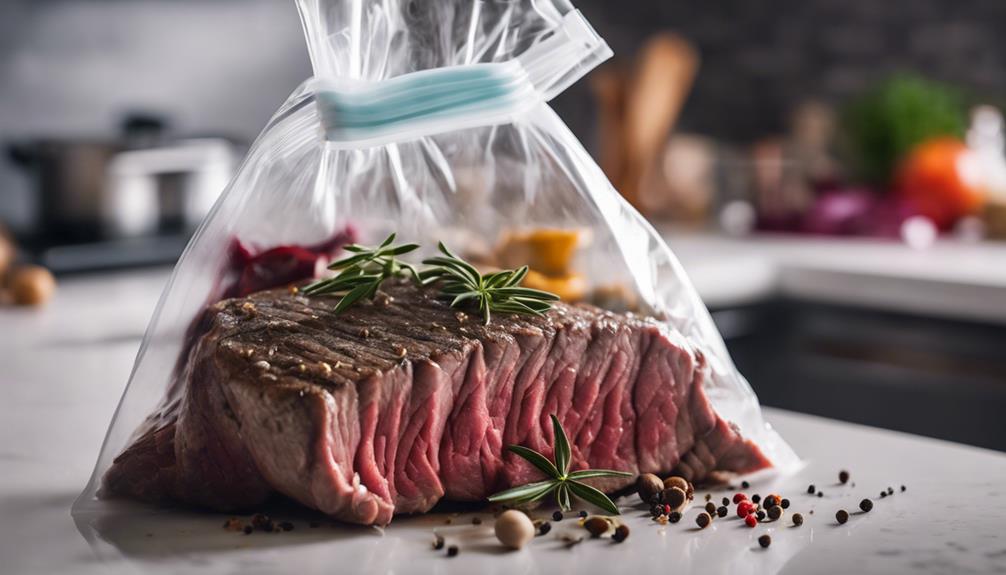
Having considered the importance of selecting the right meat cuts for sous vide, let's now explore how proper seasoning can elevate your culinary creations to new heights. Seasoning, when done meticulously, transforms the mundane into the magnificent, especially in the controlled environment of sous vide cooking. Here are three pivotal components to master:
- Marinating Basics:
Understand the science behind marination. It's not just about flavor; it's about tenderizing and enhancing the meat's inherent qualities. Opt for a balance between salty, sweet, and acidic components to guarantee deep penetration and a harmonious flavor profile.
- Spice Selection and Herb Infusions:
Choose your spices and herbs not just for the flavor but for their ability to withstand long cooking times. Experiment with combinations that complement the meat's natural taste. Herb infusions can introduce subtle, yet complex, layers to your dish, turning each bite into a culinary exploration.
- Dry Rubs and Acidic Enhancements:
Don't underestimate the power of a good rub. A meticulously crafted dry rub can create a tantalizing crust. Meanwhile, acidic enhancements like lemon zest or vinegar can add a brightness that cuts through the richness of the meat, offering a palate-cleansing effect with each mouthful.
Through analytical experimentation with marinating basics, spice selection, herb infusions, acidic enhancements, and dry rubs, you'll discover the alchemy of seasoning that turns sous vide meats into unforgettable experiences.
Temperature and Time Mastery
Mastering the precise temperatures and cooking times is crucial for achieving the pinnacle of texture and flavor in your sous vide meats. Precision control over these two variables guarantees that every cut you serve is cooked to perfection, embodying the true essence of sous vide cooking. Water baths, facilitated by your equipment choices, afford you unparalleled consistency, transforming your culinary experiments into predictable masterpieces.
| Meat Type | Temperature (°F) | Time |
|---|---|---|
| Beef (Medium) | 135 | 1-4 hours |
| Chicken (Breast) | 146 | 1-2 hours |
| Pork (Tenderloin) | 140 | 2-3 hours |
| Lamb (Medium) | 135 | 3-4 hours |
| Fish (Salmon) | 122 | 30-45 min |
Equipping yourself with the right tools for the job enhances your ability to maintain these precise conditions, while also prioritizing cooking safety. Recipe adaptation plays a pivotal role in the sous vide process, allowing you to tailor each culinary venture to the specific tastes and dietary needs of your guests. Experimentation with times and temperatures within the safety guidelines will enable you to uncover the full potential of every piece of meat, ensuring that each meal you serve is a tribute to your dedication and skill.
Vacuum Sealing Techniques
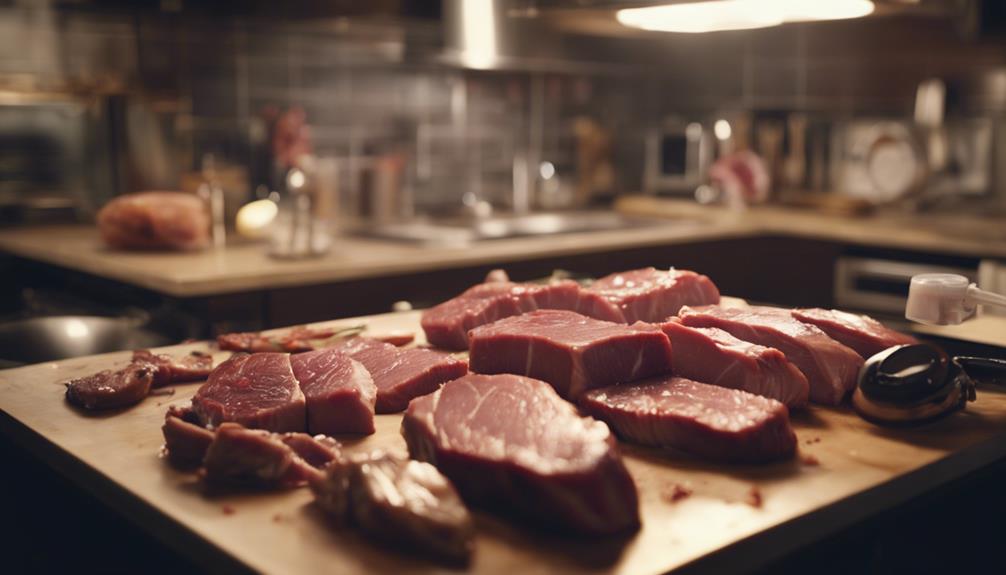
Achieving an airtight seal on your meat is essential for optimizing the sous vide cooking process, ensuring flavors are locked in and moisture is retained. The journey to perfecting vacuum sealing techniques involves understanding the relationship between seal longevity, moisture retention, equipment options, sealing techniques, and package integrity. When preparing meats for your guests, these aspects are vital to delivering an unparalleled dining experience.
Here are three pivotal elements to ponder:
- Equipment Options: Your choice of vacuum sealer impacts the quality of the seal. Experiment with different models to find one that suits your needs, focusing on those known for durability and consistency in seal longevity.
- Sealing Techniques: Master the art of removing air from the bag. Practice positioning your meat in the center, ensuring there are no folds or creases that could compromise package integrity. This meticulous attention to detail ensures moisture is perfectly retained.
- Moisture Retention: An effective seal protects the meat's natural juices, enhancing flavor and texture. Experiment with adding a small amount of butter or oil to the bag before sealing, observing how it affects moisture retention and enriches the meat's flavor.
Post-Sous Vide Searing Secrets
Once your meat emerges from its sous vide bath, the next essential step is perfecting the post-sous vide sear to reveal a flavor-packed crust. Choosing the right searing equipment is essential; a cast-iron skillet is highly recommended for its superior heat retention and distribution. It's essential to preheat your skillet to a high temperature before introducing the meat to guarantee a rapid crust formation without overcooking the interior.
Oil selection is another key factor. Opt for oils with a high smoke point, such as avocado or grapeseed oil, to withstand the high heat without burning. This choice ensures a crisp, flavorful crust without the acrid taste of burnt oil.
The intensity of the heat is crucial. Your skillet should be sizzling hot, creating an immediate and aggressive sear that locks in flavors and textures. However, it's a fine balance; too high, and you risk charring the meat beyond the desirable crust.
After achieving the perfect sear, don't underestimate the importance of resting your meat. Allowing it to rest for a few minutes before serving helps redistribute the juices, guaranteeing each bite is succulent and rich in flavor. By adhering to these techniques, you'll elevate your sous vide creations to new heights.
Pairing Sides in a Carnivore Diet
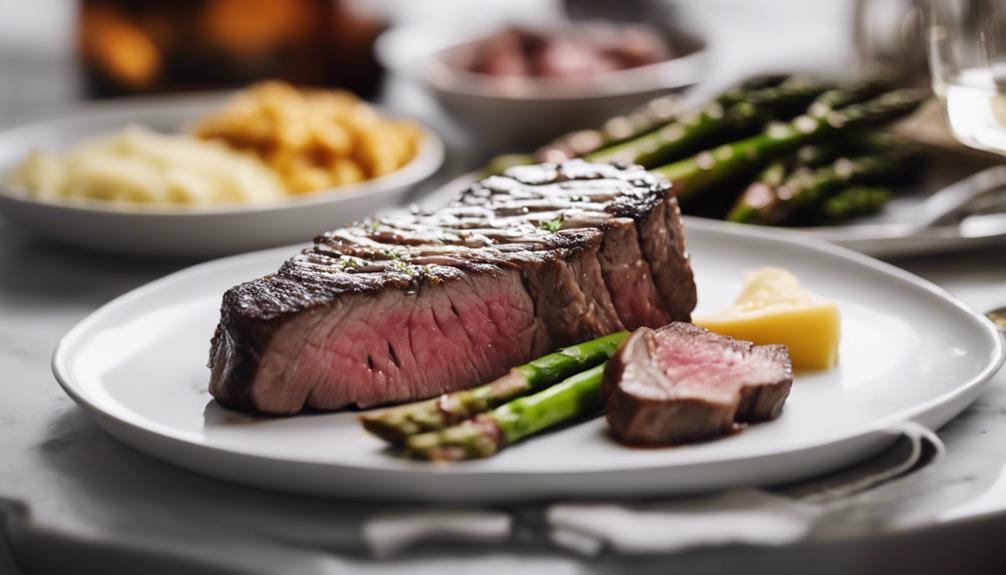
Having perfected the post-sous vide sear, it's now time to explore which sides best complement your carnivorous creations within a carnivore diet. You understand the importance of enhancing flavor without detracting from the main attraction: the meat. Let's probe into the sides that not only align with a carnivore diet but also elevate your dish to new heights.
- Zero Carb Condiments and Carnivore Friendly Sauces: These are your secret weapons. By utilizing zero carb condiments and carnivore-friendly sauces, you add layers of flavor without introducing non-animal elements. Think homemade mayo or a reduction of bone broth, intensified with spices that bring out the meat's richness.
- Animal Based Garnishes and Fat Rich Toppings: Garnishes and toppings go beyond mere decoration; they're an opportunity to introduce varied textures and flavors. Crisped bacon bits or a dollop of bone marrow butter can transform a dish, adding a luxurious depth with each bite.
- Nutrient Dense Broths: Serving your sous vide creations with a side of nutrient-dense broth not only complements the dish's flavor profile but also validates you're maximizing the nutritional value of your meal, adhering strictly to carnivore diet principles.
Incorporating these sides requires precision, an experimental mindset, and a dedication to serving others through exceptional culinary experiences.
Advanced Sous Vide Tips
Mastering advanced sous vide techniques requires understanding the nuanced interplay between time, temperature, and texture to elevate your culinary creations. To achieve perfection, you must guarantee ideal water circulation. This isn't just about setting a timer and temperature; it's about positioning your meat in the bath to allow an even flow around the entire package, preventing cold spots and ensuring uniform cooking.
Equipment maintenance is vital. Regularly inspect your sous vide machine for scale buildup and wear. A well-maintained machine is more dependable, providing consistent temperatures essential for precision cooking. This vigilance extends to sous vide safety. Always verify that bags are sealed properly to prevent water ingress, which could spoil your meat or introduce harmful bacteria.
Experiment with flavor infusions. Sous vide isn't just a cooking method but a canvas for culinary creativity. Adding herbs, spices, or even smoke elements to the bag can infuse your meat with complex flavors, which are often more pronounced than in traditional cooking methods.
Dive into recipe experimentation with confidence. Use the controlled environment of sous vide to test slight variations in time and temperature, documenting the results to refine your techniques. This analytical, experimental approach won't only improve your skills but also inspire others to explore the transformative power of sous vide cooking.
Frequently Asked Questions
How Do You Manage a Carnivore Diet With Sous Vide Cooking While Traveling or Dining Out?
When you're managing a carnivore diet with sous vide on the go, pack portable equipment and travel recipes. At restaurants, don't hesitate to make specific requests. Adapt to local cultures and pack smartly to ease your journey.
Are There Any Specific Concerns Regarding Nutrient Deficiencies When Relying Heavily on Sous Vide Meats in a Carnivore Diet?
When you rely heavily on sous vide meats, consider vitamin supplementation and mineral balance. Research antioxidant sources, adjust cooking temperatures for best fat quality, ensuring you're not compromising your health while serving others.
How Does Sous Vide Cooking of Meat Impact Its Digestibility and Absorption of Nutrients Compared to Traditional Cooking Methods?
Sous vide cooking enhances meat's digestibility and nutrient absorption through temperature precision and time efficiency. You'll experience improved flavor retention, texture enhancement, and safety benefits, making it a superior method for serving nutrient-rich meals.
Can Sous Vide Be Used to Prepare Organ Meats Effectively, and Are There Any Special Considerations to Keep in Mind?
Yes, you can use sous vide to prepare organ meats effectively. Keep in mind, temperature precision and vacuum sealing are important for maintaining organ texture. Adjust cooking times for best flavor infusion and nutrient retention.
Is There a Sustainable and Ethical Way to Source Meats for a Carnivore Diet That Aligns With the Principles of Sous Vide Cooking for Environmental Conservation?
You can source meats sustainably by focusing on local farming, ethical butchery, and seasonal availability. Reduce packaging waste through community-supported agriculture. This approach not only conserves but serves your community and environment thoughtfully.
Conclusion
To sum up, mastering sous vide in a carnivore diet elevates your culinary game to new heights.
You've discovered that precision cooking enhances flavors and textures, making even the toughest cuts succulent.
By selecting the right meats, perfecting your seasoning, and mastering vacuum sealing, you've opened up a world of gastronomic potential.
Remember, the finishing sear is essential for that irresistible crust.
Embrace these techniques, experiment boldly, and watch your carnivorous meals transform into gourmet experiences.
